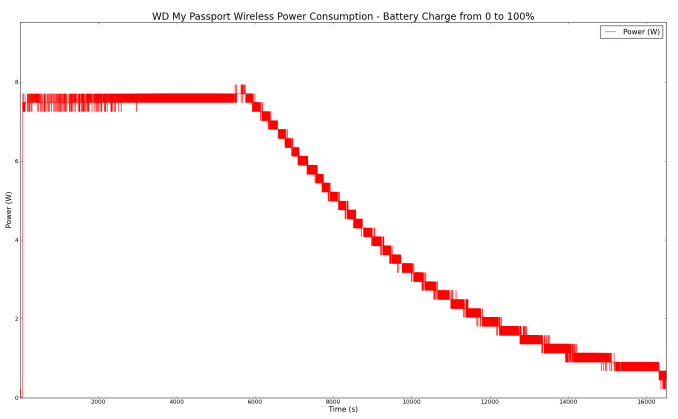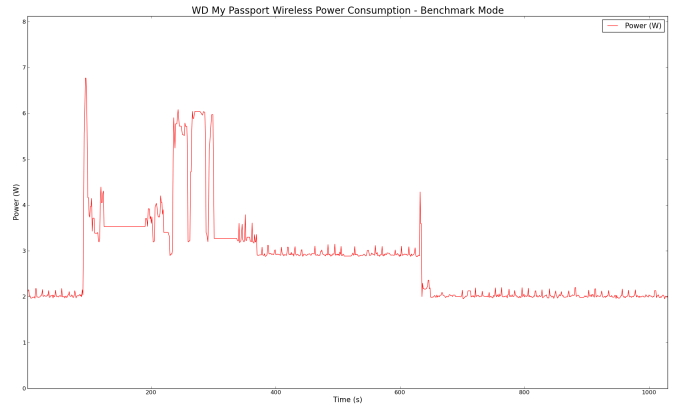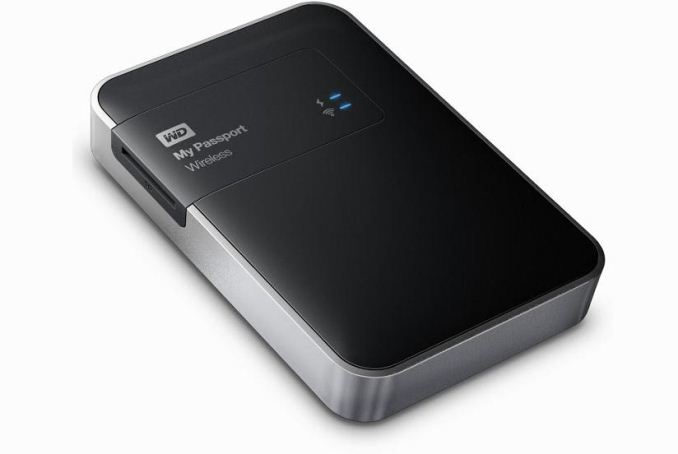Western Digital My Passport Wireless Review
by Ganesh T S on December 3, 2014 4:15 PM EST- Posted in
- Storage
- Gadgets
- Mobile
- wireless storage
Miscellaneous Aspects and Concluding Remarks
Battery life is an important aspect for wireless storage devices. Western Digital claims up to 6 hours of run-time on the battery, but we saw it was close to 5 hours (without actually streaming anything). To get a better idea of the actual power needed to keep the internals running, we connected the drive and its charger to a Ubiquiti mFi mPower unit. In the first pass, we recharged the battery from 0 to 100%. The graph below shows the power consumption at the wall for this process.
We find that the charging process with the supplied charger takes slightly more than 98 minutes to complete. During this period, the power consumption at the wall is around 7.55 W. This closely tracks the mAh rating (3400 mAh) of the Li-Po battery that we saw in the FCC teardown. After the charging process, the unit was switched on. However, with no activity, the drive moves to idle and eventually standby mode. In the standby mode, the power consumption is only 0.5 W.
In the second power graph, we show the behavior during the benchmarking process.
We find that the drive spin-up from idle draws close to 7 W. After that, streaming with disk read-outs consumes around 6 W.
Coming to the business end of the review, it is clear that WD has succeeded in differentiating itself in the crowded wireless storage market. Targeting the photographers with FTP support and a built-in SD card slot (with auto-import capabilities) makes the product stand out. The unit is DLNA certified for those reliant on a media server for their media consumption needs. It also exposes the contents as CIFS shares. Users who want to utilize the unit outside the My Cloud app also have nothing to complain about. Possible areas of improvement include better battery life (either with a higher capacity battery or better firmware) and a more modern Wi-Fi chipset for faster transfers and more reliable streaming of high bitrate content.
The product uses the highest-capacity 2.5" drive currently available. In terms of capacity, the closest competitor is the Seagate Wireless Plus at $200. The My Passport Wireless 2 TB variant currently retails for $220. A $20 premium for the extra features in this multi-purpose wireless storage unit is, in our opinion, completely justified.













23 Comments
View All Comments
marvdmartian - Tuesday, December 16, 2014 - link
Hey, more power to you, if that's what you're looking for. My point was rather to state that there are less expensive (and more effective) solutions, IMHO.name99 - Thursday, December 4, 2014 - link
OMG it's running an A8.CONFIRMED: Apple is selling CPUs to third parties!!!
:-)
michaelbbateman - Friday, January 23, 2015 - link
By using this WiFi drive from my laptop, I am effectively disconnecting my machine from the internet, unless I am missing some core concept here? I mean this guy creates it's own network with no internet connection and I abandon my usual network connection in favor this new one and that's it, right? Am I missing something?